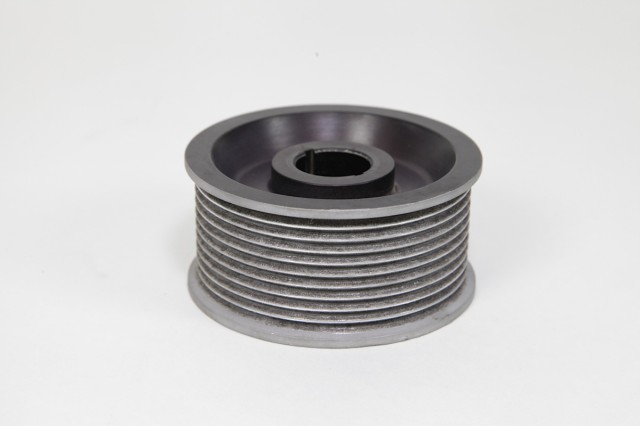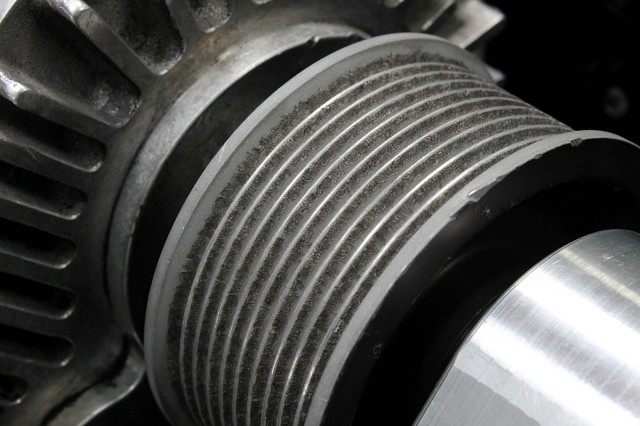
Innovations within the racing world are sometimes carried into other businesses or industries as well. Sometimes those roles are reversed. With innovations from one industry being picked up and used within the racing industry. That’s what happened with Carbinite, a company that focuses on improving industrial equipment, mill rolls, work-holding fixtures, pipe-gripping equipment for the oil and natural gas industries, etc.
The Issue
Our in house classic Mustang known affectionately as Project Biting The Bullitt is making over 1,000 hp at the crank with it’s Paxton blown Windsor engine. When a ribbed supercharger belt is used in high output situations like ours instead of a more expensive cog-drive system there is a greater potential for supercharger belt slip. The belt slip occurs in part due to the limited surface area for the belt to grip on the small diameter blower pulley. Slip often occurs during the violent RPM changes of hard acceleration and gear changes. That translates into lost power and inconsistent performance on the race track.

Our blower pulley after receiving the Carbinite coating. Notice the rough looking nature of the pulley grooves. The Carbinite coating applies a Carbide coating that feels like 100-grit sandpaper, gripping the belt and keeping it from slipping.
We’re all car guys here and we saw what was happening and decided to come up with a solution.
Carbinite owner Drew Towns tells us, “We’re all car guys here and we saw what was happening and decided to come up with a solution.” The solution was to apply Carbinite’s industrial coating to blower and even crank pulleys.
What Is Carbinite
Carbinite is a textured carbide coating. “Once it’s applied it feels a lot like 100-grit sandpaper,” says Towns. The coating increases the grip of the surface it has been applied to – in our case the supercharger pulley. Like putting grip-tape on a skateboard or stair tread the pulley goes from a slick, bare metal surface to one that has high levels of grip.
The Carbinite coating is applied in a process similar to welding at a much lower temperature. The tungsten-carbide rod transfers the material onto the pulley. Both sides of the pulley grooves are coated for maximum grip.
Carbinite is applied to the pulley surface using a consumable rod. “The process is similar to welding but at a very low heat,” says Towns. That consumable rod is made from tungsten-carbide. An electric current is passed through the rod as it is touched to the V-grooves of the pulley. Towns says the amount of current that is run through the rod will dictate the thickness and overall texture of the coating. “Once we’re finished it’s like having a permanently affixed piece of sandpaper on your pulley,” says Towns. The final coating has a 72 Rockwell rating for hardness.
Once applied the material becomes a permanent part of the coated object. Carbinite can be applied to steel or aluminum pulleys and Towns says they can typically turn around a pulley for a customer in two to three working days.

Our blower pulley back in place on our Paxton supercharger after it received the Carbinite treatment.
While the coating sounds like it may be harsh on the belt Towns says they actually tested it thoroughly on a supercharged Mustang for a few years prior to offering the service to enthusiasts. “We ran the same belt for a couple of years, took the car to the track, drove it on the street, etc.” That car was on a ’03 Cobra that had its blower pulley machined smaller than anything commercially available so that the Carbinite crew could test their coating on a pulley that offered minimal surface area. “This was a litmus test. Minimal amount of wrap angle and surface area, maximum blower RPM.”
The coating is so effective that NMRA Renegade racer Brian Mitchell used it during his season-long championship run in 2013. Mitchell went undefeated in NMRA competition for the entire ’13 season.
Carbinite offers their coating on blower pulleys under four-inches for $99.99. Crank pulleys are done on a case by case basis depending on the size of the pulley. We’re currently giving Project BTB an exterior makeover, when we get it back on the track we won’t have any worries about the blower pulley slipping.




















